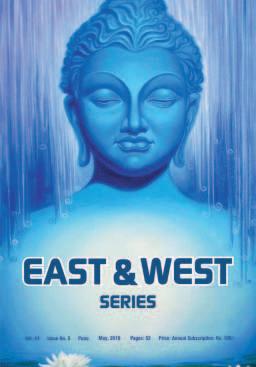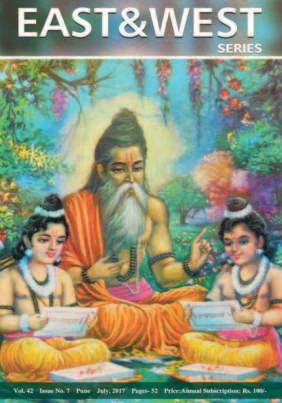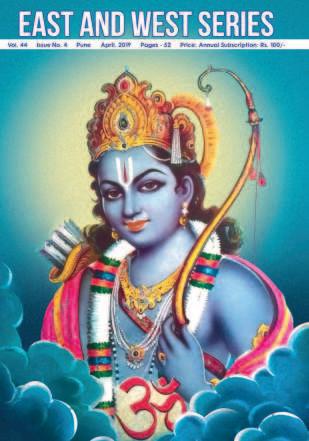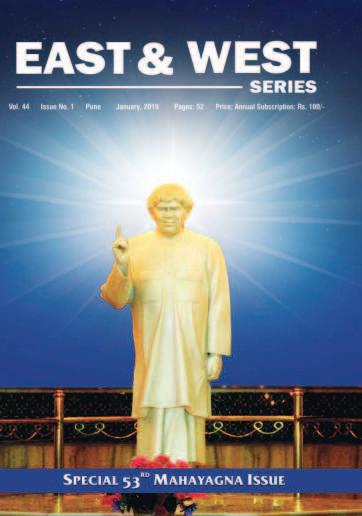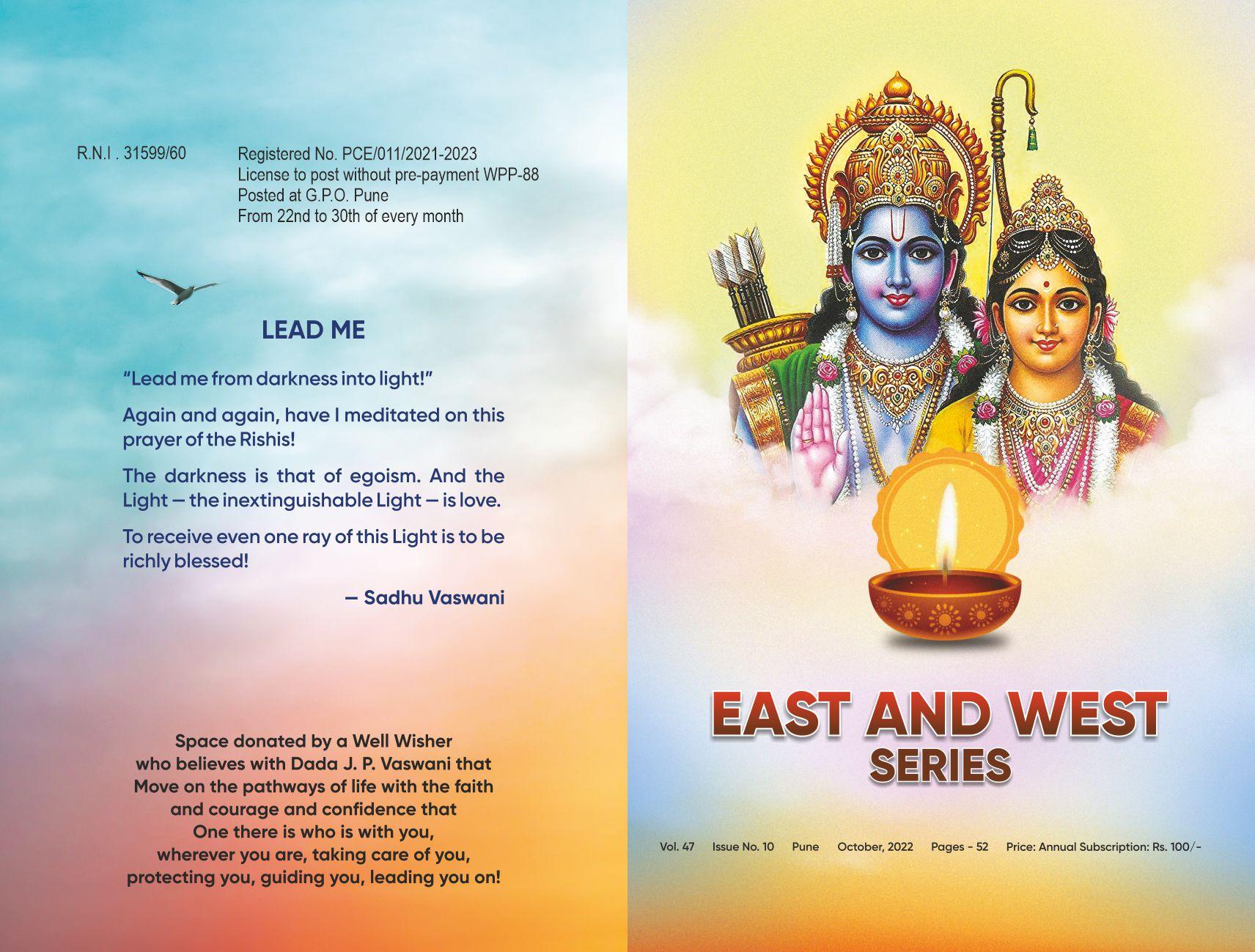

Sri Rama* And The Aryan Ideal
SADHU VASWANIThe kingdom of Ayodhya was filled with illumination and joy when Sri Rama returned from Lanka. The day of his return is celebrated as the Deepavali, the Feast of Lights. A new cycle in India’s history began that day.
To accept history is to accept wars as well. To disavow war as a crime is to forget that history is, in no small measure, a record of crimes. And to combat crime, unrighteousness, adharma, and build a Kingdom of the Light appear, from time to time, radiant Spirits who open in history, windows of illumination.
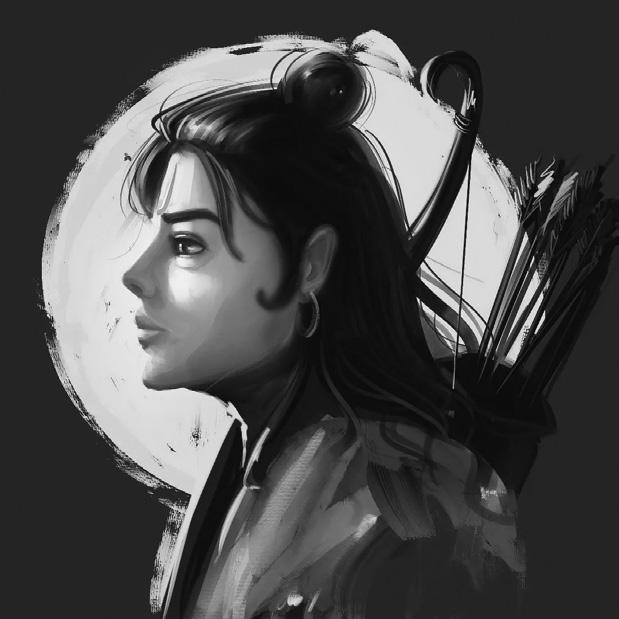
One of these radiant Spirits was Sri Rama. He belongs to a far-off age. It is marvellous that a name so ancient as Sri Rama has come to us down the stream of ages, and has enthralled the memory and imagination of millions upon millions of men and women in Hindusthan.
Sri Rama is the first great Hero of the Hindu Race, our first avatara of shakti. He measured his strength against the great king of Ceylon — Ravana. Ravana had kept confined Sita, the queen of beauty and purity.
*October 24 is sacred as Deepavali day.
Ravana looked on Rama and wondered how Rama dared to fight against the huge army of Lanka. Rama was slim in body and his clothes were forest leaves. But as Rama shot arrow after arrow on the battle-field, Ravana saw differently. The arrows struck Ravana: Ravana fell! Sri Rama was victorious: but he did not annex to his kingdom the country of Ceylon. On its throne Sri Rama set up a worthy son of the soil and departed for Ayodhya.
Year after year does India celebrate these two days — the day of Rama’s Victory (Dussehra) and the day of Rama’s return to Ayodhya (Deepavali) — as two of her greatest days. The Dussehra and
the Deepavali are our annual festivals in honour of Sri Rama. In these festivals I hear a voice of love and gratitude — love for the Aryan Ideal, gratitude to Sri Rama for his great victory over Ravana. It was a victory of the Aryan Ideal over a sense-dominated civilisation represented by Ravana.
The Aryan Ideal represented sense-control, purity in personal and social life. The “cult of the naked,” sweeping swiftly over the West today, is the very opposite of the Aryan Ideal. Dussehra is a reminder to us of the victory of the Aryan Ideal.
I confess I feel in me a gravitation to the Aryan Ideal. I feel its beauty, I find it difficult to describe it as I would if I were asked to describe the beauty of the flower or the butterfly.
Out of the strong come sweet influences. And Sri Rama the warrior had such sweet, tender love for the poor. He gave them love: he lighted up the manhood of the poor. On one occasion, he would not be a guest of the Rajahs (kings) or even the Rishis (sages). He blessed the cottage of poor Shabri.
Both Rama and Sita are pictures of tapasya. “I will go to the forest with thee,” says Sita to Rama, leaving to Arundhati her jewels and necklaces, Sita goes with Rama, leaving the palace, to be with him in exile, and spend many years in the
tapobana. She has renounced her all to be in the company of Sri Rama, her Lord. Her life was centred in Rama. She could not live without him. To Hanuman, she said: “My child! In one form
I am Sita: in another form I am Rama!”
Sita eats the coarse forest food which Rama takes. She suffers separation from Rama when she is forcibly taken away by Ravana to far-off Lanka. She passes through the ordeal of fire, after she is united with Rama. She spends her last days in tapasya in a Rishi’s hermitage. “From my birth,” she says, “sorrow marked me, child of the Earth. I seek in tapasya the breast of my mother.” Not without reason is Sita revered as Loka-Mata, the World-Mother.
Sita is unparalleled in all history. Helen of ancient Greece had singular beauty. But in Sita, beauty was blended with purity and spirituality. Helen was the woman natural, Sita the woman divine. And divinity shines in tapasya.
Is not the very name “Sita” significant? It means “furrow of the plough.” The furrow does hard work in the earth. Sita, a child of the palace, Sita, full of grace and beauty, was destined to be trained in a school of hardness, tapasya.
Soon after she married Rama, Dasaratha asked his son to go into exile, for fourteen
years. Rama said he must not take Sita with him to the forest, for the forest was a world of fear, full of bears and tigers and wolves and lions and wild elephants, demons and serpents: and Sita would get no food in the forest, except sour fruits and roots, and she must in the forest sleep on stony ground. Then to Rama, Sita said with tears in her eyes that to be with him was to be in a palace, that a long journey with him would be a joy to her, that sour fruits would be sweet as the food of the gods, and that if he left her, her heart would break.
How much she suffered in the forest and, later, in Lanka, when forcibly removed by Ravana! And after Rama’s victory over Ravana, she was called upon to go through fire. Sita’s was a path not of roses but of flames. Sita was the very picture of tapasya. Therefore, history remembers her and salutes her as an immortal.
Money and power pass away: what lives and is cherished as sacred in the memory of men is sacrifice. It is the Eternal in time. Sita stands for all time a symbol of sacrifice.
The supreme lesson of the Ramayana is tapasya. It is the lesson of Hindu literature and of the Hindu Faith. To enrich their lives with the wealth of tapasya, India’s kings and princes left palaces and went in quest of the Eternal. And they did tapasya
not as pessimists sick of the world, but in the immense faith of the optimist, believing that life is a festival, a sacrament, a communion with the Beautiful.
The world has worshipped wealth and power. But the richest wealth is self-offering: the greatest power is tapasya.
To live is to breed — say many today. To live is to sacrifice — says India.
To be great is to scramble for goods — says Europe. To be great is to commune with the Eternal Good — says India.
Europe is filled today with vibrations of hate and strife and violence. Europe needs to be brought into contact with the genius, the soul of India. Race-contacts produce renaissance, renewal among nations. To initiate and develop a new movement of renewal, Europe must meet India as a comrade, renouncing race-pride and exploitation.
Much there is which modern India has to learn of Europe. And Europe, too, has much to learn of India. Her philosophy and literature bear witness to the dignity of a disciplined civilisation evolved by her long before Europe looked upon her with passion-filled eyes. Let Europe meditate upon Sita and be purified.
A Prophet Of Compassion*
SADHU VASWANIIn love and utter simplicity, Francis mingles with the poor. He admits no one to his Order who will not strip himself of all things, retaining nothing for himself. Francis believes profoundly in the teaching of his Master: “Go and sell all thou hast and give to the poor!”

A peasant meets Francis, saying to him: “O saint of God! I long to serve God. Blessed am I to have met you! Accept me in your Brotherhood, and tell me what I should do to please you.”
Francis says to him: “Brother! if you will, indeed, be of my company and my interior
life, go part with all your goods and give them to the poor.”
Francis understands what a blessing it is to belong to the brotherhood of the poor. “It was a quicker journey to God from a hut,” he says, “than from a palace.” And poorer and purer than the “poor” are birds and animals. How much Francis loves them!
A youth has caught a number of turtle-doves and is taking them to market. He meets Francis on the way. “I pray thee, give me these gentle birds,” says the saint. The good youth gives them all. And Francis receives them into his
bosom, talks to them tenderly, and builds nests for them all.
A fisherman brings to Francis a water-fowl. Francis accepts the bird, then opens his hands to let it fly away. Another fisherman brings to him a great fish alive. Francis puts it back into the water of the lake. He speaks to swallows: he preaches to birds.
So great was St. Francis’ love for the larks and other birds that he, on one occasion, said in tender, touching words: “How happy would I feel if all the mayors of the cities and all the lords of the castles and towns would solemnly promise every year on the day, sacred as the birthday of our Lord, to induce their men to do one thing — to throw their wheat and their grain along the roads beyond the cities and walled towns so that our sisters, the larks and other birds, may have plenty to eat!”
His love tamed even a wolf: the “good wolf of Gubbio” they called the “little brother of St. Francis.” Animals respond to love: but we, alas! torture them. “By what cries of pain,” writes Countess Caesaresco, “by what looks of love have not beasts told men that they thought!” “Behold the animals! There is not one,” writes Edward Carpenter, “but the human soul lurks within it, fulfilling its destiny as surely as within you!” The “God of the granite
and the rose” is, also, “the soul of the sparrow and the bee” and the spirit of the tender goat and the mild cow and lamb.
The nations, alas! are wandering today in a “jungle” of “civilisation”. The nations love violence: they trample upon the great vision of the One Life in all. Modern civilisation is baptized in blood. Even India is forgetting her ancient vision of reverence for life. I have heard “educated” Indians speak, echoing the words of some Western books, of “humane” slaughter! As well might we speak of “humane” murder! Stop all slaughter, brother!
St. Francis was a brother of all animals, a brother of life, a brother of all creatures. In his heart he communed with the Brotherhood of Life. An influence moved out of him, a strange, psychic influence: it enveloped others with the tenderness and love of his heart which felt for all creatures, human and sub-human.
He met, one day, a woodcutter chopping down a tree. To him, Francis spake: “Brother! do not chop off the whole tree, but give it a chance to grow up again.” And Francis offered him his food for the day.
Francis loved plants and flowers: when he saw flowers, he was filled with joy. Francis, like Buddha, embraced all creatures in love. Buddha carried on his shoulders a goat,
which was being led to the sacrificial altar, and, meeting the King of that place, said: “Sire! I offer myself as a sacrifice in the place of this poor, helpless, bleating goat.” And the King was so moved that he released the goat. Francis blessed the wolf and, with the power of love, transformed the wolf into a mild animal.
Francis was a wanderer without house or home: this homeless wanderer found his home in Nature and in the hearts of all creatures. In his “Canticle of the Sun,” he praises “Brother Sun,” through whom God doth light us: the Sun, Francis says, is a living image of “my Lord, the Highest.” And Francis praises the Moon and Stars as his “sisters”, the Wind as his “brother”, Water as his “sister”, and Fire as his “brother” through whom “Thou, O Lord, dost illuminate the night!” And Francis praises the Lord through “Mother Earth, rich in fruits and coloured flowers and grasses.”
Remarkable is his “Canticle of the Sun.” It shows that the heart of the saint was filled, through and through, with cosmic emotion for Nature, for the Sun and the Moon and the Stars, for Fire and Water, for all the elements which are indeed emanations of the Lord, making the Universe a Temple of beauty and joy. St. Francis’
“Canticle of the Sun” has reminded me, again and again, of Guru Nanak’s invocation to the Lord of creation, called aarati. Listen to the following words of St. Francis
Most High, Omnipotent, Good Lord!
To Thee be the praise, The glory, the honour and all benediction:
To Thee alone, Most High, do they belong, And no man is worthy
To name Thy Name!
To Thee be praise
In all Thy creatures, Lord!
Praise be to Thee for Brother Sun!
By him is the Earth illumined, day by day: And radiant is he and bright. With what splendour shineth he!
The Sun, indeed, is a symbol of Thee!
To Thee be praise
For Brother Fire, my Lord! Thou dost by Fire Illuminate night after night, How noble is Brother Fire!
How beautiful! How robust and strong!
To Thee be praise
For Sister Water, Lord! How humble is she! How useful, too! Ever chaste is she, Pure beyond compare!
To Thee be praise, my Lord!
For Sister Moon and Stars.
In heaven they shine: How fair!
How clear! How precious!
To Thee be praise
For Brother Wind, my Lord!
For Air and Clouds: For times serene and stormy. To Thee be praise forever!
To Thee be praise, my Lord!
For Mother Earth, Who doth sustain and keep us. And bringeth forth fruits And coloured flowers and grass!
To Thee be praise, my Lord!
For those who pardon for Thy love, Who bear infirmity and tribulation.
Blessed are they Who will in peace endure: For Thou, Most High, Shall give unto them a crown!
To Thee be praise, 0 Lord!
For our Sister Bodily Death
From whom no man can escape. Alas for them who die in mortal sin!
Blessed are they Who are found in Thy Holy Will,
For the second death will not work them harm!
His feeling for Nature became for him a key to a new world of kinship and sympathy. Has it no message for the modern man? In India,
in the long ago, men lived in fellowship with all creatures, with all life. Creation was one Family in God! This vision of cosmic unity inspired the ancient rishi, when he sang “Ishavasyam sarvam idam!”
“All that is, is a vesture of the Lord!” In this message of unity with flower and field, with bird and animal, there is, methinks, a hope for mankind.
Leibniz, the great French philosopher, was a seer. He had the beautiful idea, the profound vision, that life on earth had three manifestations. Life sleeps in plants: life dreams in animals: life wakes in man. Yes — life is one: and the One Life that wakes in men, dreams in animals. Bruno, one of the great minds of the Middle Ages, pointedly said: “Among horses, elephants and dogs, there are single individuals which appear to have almost the understanding of man.”
Francis became the great awakener of his age. A new awakening is the world’s piteous need, today. New sons and daughters of Krishna and Buddha, of Mahavir and Francis, are needed, today, to reveal anew the beauty of reverence for life — sons and daughters, who would, renouncing eminence and honours, greed and greatness, be among the servants of animals and humanity.
A lady doctor once asked me if I took vitamin supplements. I answered in the affirmative. “Do you take the real vitamins?” she persisted.
“Real vitamins?” I said, “I have heard of vitamins A, B, C, D, E and K – which of them is the real vitamin?”
“None of them,” she replied. “The real vitamins are the vitamins W – Water and Walking!”
How many of us are physically fit? How many of us devote at least a little time every day to physical activity –walking or cycling or swimming or some form of sport?
“Where is the time for all that?” some of us ask in exasperation.
“I am exhausted when I get home, I can’t be expected
VITAMIN W: The Real Vitamin
DADA J. P. VASWANIto trudge out at six in the evening?” some people may say.
Yet others have their own excuses: I don’t like to sweat; I don’t look good in track pants; it’s too boring, etc. etc.
All of us have used these excuses at one time or another. The truth is that we are reluctant to take up any form of exercise.
There are no two ways about it – physical activity of some kind is vital for good health. And physical activity must be regular, for its beneficial effects cannot be stored. Exercise must become a habitual part of our daily life.
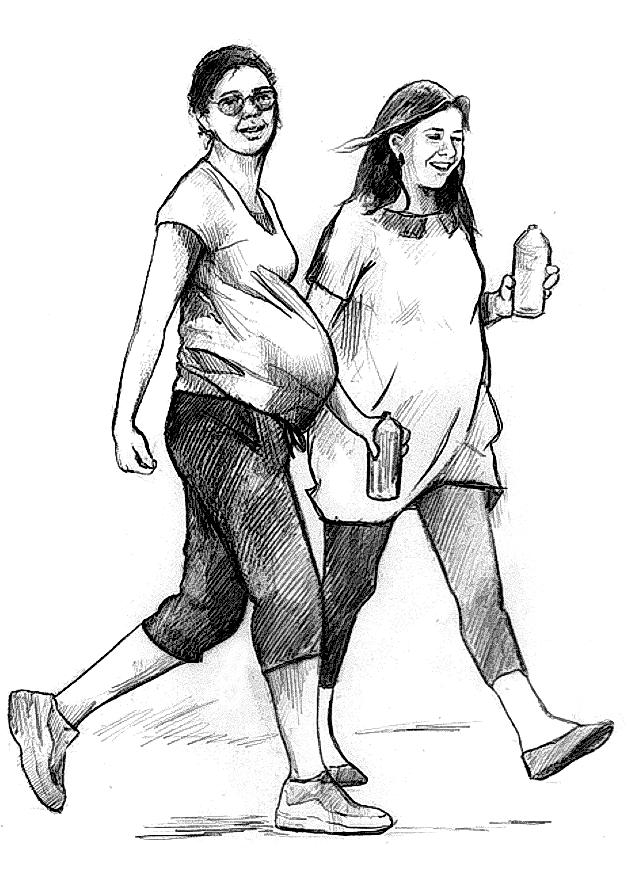
“Exercise” sounds complicated. It may need special garments – shorts, track suits, leotards. It may need special equipment – treadmill, weights, exercise bikes, etc. All this means spending money. And we all know – we do not always use all that we buy.
To every one of you who is put off by the word “exercise”, my advice is, “Forget exercise. Just walk”.
Walking does not need any expensive equipment. It can be done in any lose, comfortable clothes that you are used to wearing. Walking is easy and simple – and it can be done practically anywhere!
Consider the benefits of daily walking. It can:
• Keep you fit.
• Tone your muscles.
• Improve your figure and posture.
• Increase your heart and lung capacity.
• Relieve stress.
• Burn calories.
• Help you reduce weight.
• Brighten your mood.
• Make you look and feel young.
One of the maladies of our so–called better life style are the many labour–saving devices to circumvent the need for using our muscles. As a result, many of our muscles are no longer able to perform properly, some of the functions for which they were originally intended.
The sedentary lifestyle of some of our senior executives and professionals makes them prone to several diseases, which are largely caused by lack of proper exercise. By the same token, we can see that many of these ‘lifestyle’ ailments maybe remedied or even prevented by appropriate exercise.
The list of modern ‘diseases’ that are directly related to lack of adequate exercise, is long – cardio vascular disease, varicose veins, hernia, obesity, constipation... the list is endless. It is next to useless to try and treat their symptoms alone, with medication or surgery.
One of the most unfortunate aspects of modern life is that even our children – especially those living in larger cities –are not only deprived of proper exercise, but also spend the better part of their leisure sitting staring at the TV screen. They are denied sunshine, fresh air, and the exercise that is necessary for their physical development. As a consequence of this unnatural lifestyle, flabbiness and overweight are common in well-to-do children.
I read of a man who consulted a doctor about his wife’s persistent illness. The doctor recommended regular exercise.
“Exercise?” the man retorted. “The only exercise my wife ever gets is running up huge bills and jumping to conclusions.”
Lack of proper exercise, in addition to other physical ailments, also leads to stress, nervousness and irritability. Thousands of us swallow
sedatives and tranquillisers that have harmful side effects on our systems – when a brisk walk in the fresh air can work miracles on us.
Mahatma Gandhi writes: “Exercise is as much of a vital necessity for man as air, water and food, in the sense that no man who does not take exercise regularly, can be perfectly healthy.” In his Health Guide, Gandhiji recommends physical and mental activity, to promote a sound mind in a sound body. For our work should be neither exclusively physical nor exclusively mental – nor should it be that which merely provides pleasure for the moment.
Walking has been described as the queen of exercises. The reason why the sadhus and fakirs of ancient India were fit and healthy, was because they went from one end of the country to another, on foot.
The great American writer, Thoreau, was a tremendous source of inspiration to Gandhiji. Thoreau was such an enthusiastic walker, that he would walk for four or five hours a day. He even said that all his best works were conceived and composed when he was walking!
We may be performing complex mental or intellectual tasks. But it is imperative that
we should set apart some time at least for exercise – just as we always manage to find time to eat. For even the highest form of mental work can benefit from an increased level of physical activity.
There was a rich man who suffered from severe indigestion and loss of appetite. He went to consult his doctor, and was advised to walk a little every day. He protested that he was too weak to walk at all. The doctor invited him to ride in his carriage, for a drive. On the way, the doctor deliberately dropped his whip. Out of courtesy, the patient climbed down to pick it up. But the doctor drove away, without waiting for him to get back into the carriage. The poor patient was forced to walk as best as he could behind the carriage.
When the doctor was satisfied that he had walked long enough, he stopped the carriage and took him into the carriage again. “I am sorry I had to do this,” he explained. “But it was the only way to make you walk!”
The man was dropped at home and he suddenly realised that he was very hungry. For the first time in several days, he sat down to a hearty meal – and realised the value of the doctor’s advice.
When you take a brisk walk, you will see for yourself that you feel light and brisk, and that your breathing becomes deep and rapid. Walking gives exercise to all parts of the body, ensuring vigorous circulation of the blood. This in turn, improves our metabolism, promotes the efficient combustion of food and removal of toxic substances. This creates the necessary body warmth and also more energy for work.
We all know that exercise makes us physically fit. But now, psychiatrists are beginning to tell us that physical exercise can actually enhance emotional wellbeing too! “Exercise is emotional aerobics,” says Bob Connoy M D, a psychiatrist at the Penninger Clinic in Topeka, Kansas. The emotional benefits of exercise are many. It can:
• Relieve tension and anxiety.
• Strengthen the body’s ability to cope with stress.
• Clean the mind, improve concentration and continue to enhance a sense of well–being.
• Improve sleep.
• Reduce depression.
• Generate optimism and self–confidence.
Any form of exercise releases pent–up tension. Soon after a brisk walk, you feel relaxed, refreshed and energised.
Pray While You Walk!
Let me quote to you these beautiful lines from Thich Nhat Hanh, a Buddhist monk:
The mind can go in a thousand directions.
But on this beautiful path, I walk in peace.
With each step, a gentle wind blows.
With each step, a flower blooms.
Nanh tells us that walking meditation can be very enjoyable. This will enhance your awareness of the present moment, and enable you to inhale not just the fresh air around you, but peace and happiness.
Everyone agrees that thoughts are difficult to control. While we walk on one path, our thoughts race on a million pathways. If we can turn our path into a path of meditation, we will find our benefits multiply!
It was Gautama the Buddha who first initiated this beautiful art of walking meditation. When he came to dwell in the forest of Uruvila, he took his disciples on these meditative walks – thereby paving the way for us all to take steps to peace and joy.
Medical Benefits of Walking
It has been proven that regular walking can actually
prevent illness. It cuts down the risk of chronic diseases by as much as 30–40%.
Walking keeps the heart healthy. It increases blood supply to the heart, lowers blood pressure and enhances the level of HDL – the good cholesterol in the blood. It reduces the risk of a stroke caused by clotting of the blood.
Doctors also say that walking can prevent the development of Type 2 diabetes in obese people.
By building up the bones and muscles it reduces the risk of osteoporosis in later life. (With a healthy intake of calcium.)
It also reduces pain in patients with osteo-arthritis by strengthening the muscles around the joints.
Above all, walking is a proven remedy for depression and low spirits.
Water
It would not be out of place to say a few words here about water. In the absence of food, man can subsist on water alone for several days. This is because over 70% of the human body is composed of water. In fact, 70% of all the food we eat consists of water.
Unfortunately, we fail to drink enough water every day. Also, we fail to pay attention
to the purification of the water we drink. Impure water, or water from contaminated sources can harm the system. The water you drink should therefore be boiled, filtered and stored in a clean container. We live in a world where people pay to get bottled drinking water – something that would have shocked our ancestors beyond belief!
Water helps to flush out the toxic wastes in our body. It controls the body temperature by being given out as perspiration. Experts have calculated that there is a daily loss of four and a half pints of water through our skin, lungs, kidneys, and alimentary canal. Needless to say, this loss must be replenished.
It is good to drink water whenever you are thirsty. However, it is better to drink water after a meal than with it.
It was a wise man who said: “Drink your food and eat your water.”
No, he hadn’t got his verbs mixed up! What he meant was that food should be chewed, masticated so well that it glides down like a liquid when we swallow it. And water should not be gulped down hastily –but sipped, savoured and taken in slowly!
Unto Gandhi
O Gandhi! In this mess of modern life,
I cry as cries an infant in the night!
I cry to thee, O prophet of the Light! Lift us above the noises and the strife!
And make thy India strong again and new!
Where are thy loved ones — the village-folk?
Once stood they storm and gale as does the oak, But now so weak! Alas! we are not true,
We are not simple men, and we have lost Our God, our Holy Shrines and India’s gold
Of wisdom: we to greed and earth are sold! Remember we the Mother who hath fought
Through ages for the Freedom still afar?
Remember we the poor who wander still?
Behold! thy Country sorrows and is ill! O Gandhi! shine on us as a healing star!
Poona
Mahatma Gandhi’s Birthday 02.10.1954
*October 2 is celebrated as Mahatma Gandhi Jayanti day.
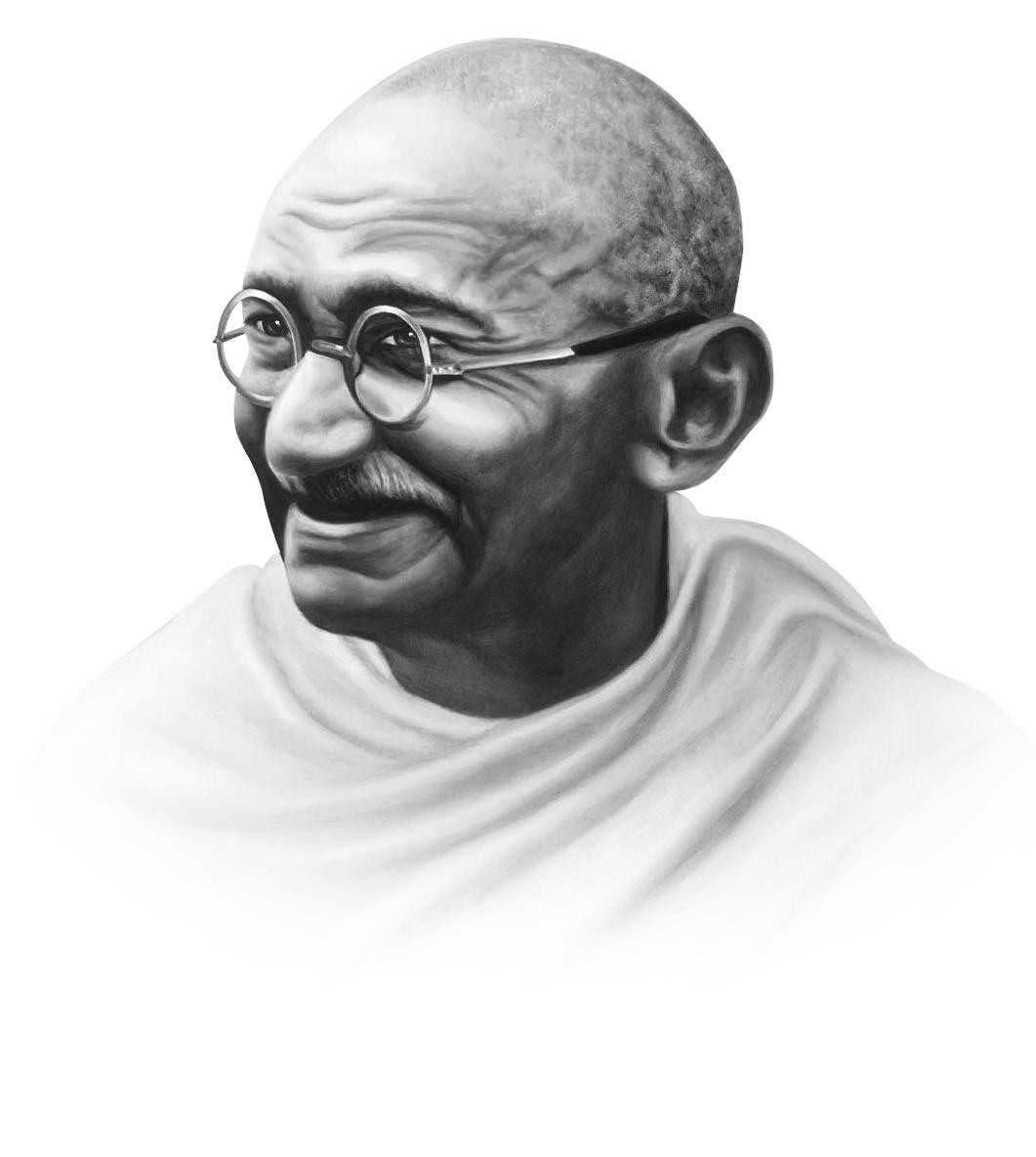
LAUGH

YOUR WAY TO HEALTH
Agent to writer: I’ve got some good news and some bad news.
Writer: First tell me the good news.
Agent: Paramount just loved your story, absolutely ate it up.
Writer: That’s fantastic! And the bad news?
Agent: Paramount is my dog.
***
Husband: I have tickets for the theatre.
Wife: Wonderful, darling. I’ll start dressing right away.
Husband: That’s a good idea. The tickets are for tomorrow night.
***
After attending a prayer meeting where everyone prayed very loud, a little boy remarked, “If they lived nearer to God, they wouldn’t have to pray so loud.”
***
Daughter: Oh, Mother, please tell me if I should accept Joe’s proposal.
Mother: Why don’t you ask your father? He made a much smarter decision in marriage than I did.
***
Burglar: The police are coming! Quick, jump out of the window!
Accomplice: But we’re on the thirteenth floor!
Burglar: This is no time to be superstitious.
***
Millionaire: What’s your name, driver?
Driver: Alfred, sir.
Millionaire: I always call my drivers by their last names.
Driver: It’s Sweetheart, sir.
Millionaire: Drive on, Alfred
***
First husband: I think my wife is getting tired of me.
Second Husband: What makes you feel that way?
First husband: She keeps wrapping my lunches in road maps.
Children’s Corner
DIWALI QUIZ:
1. How many days after Dussehra does Diwali fall?
2. Which countries have an official Diwali holiday?
3. For How many years did Sri Rama go for Vanvas?
4. The name Diwali is derived from the Sanskrit term dipavali. What is Diwali’s English translation?
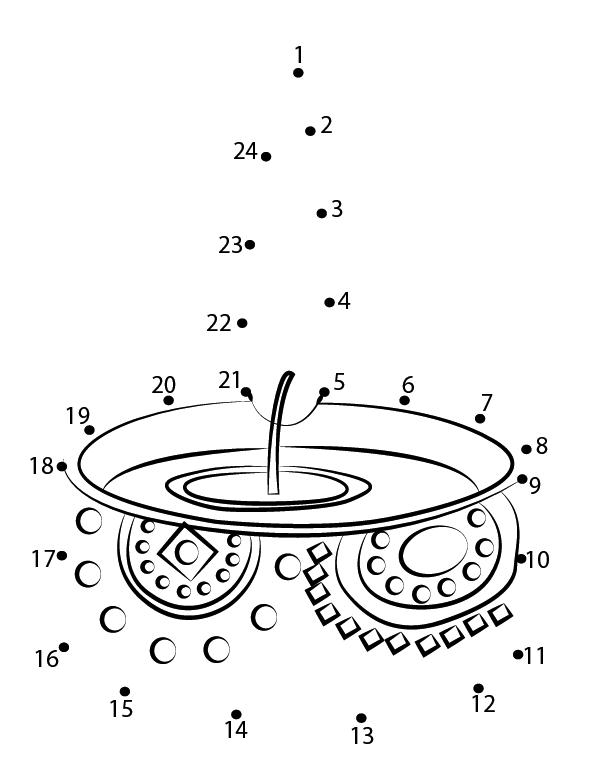
5. Other than Hindu, which other religious groups celebrate the Diwali festival?
6. Which sweet is mainly made during Diwali?
7. In what way do people celebrate Diwali?
8. How many days Diwali lasts for?
9. Which is the first day of Diwali, dedicated to cleaning homes and purchasing small items of gold?
10. Which day of Diwali, commemorating Krishna’s defeat of Indra, is called Goverdhan Puja, Balipratipada, or Annakut?
11. Which day of Diwali celebrates the bond between brothers and sisters?
,Gujia6-by7-lighting,diyas58-days,9–Dhanteras,10–Fourth,11–Fifth.
ANSWERS:1-21,Trinidad2-and,Tobango143-,yearsrow4-of,lights,Jains5-
THE DOTS:
RECIPES FOR
DAHI BHALLA
Ingredients: For The Vadas:
Urad dal (split black lentils), soaked for
Hours
Roughly chopped green chillies
Roughly chopped ginger (adrak)
For The Topping:
Whisked curds (dahi)
Powdered sugar chilli powder
tbsp
Khajur imli ki chutney
cumin seeds (jeera)
sprinkling
cups
tbsp
sprinkling
salt (sanchal)............................
For The Garnish:
finely chopped coriander (dhania)
Method: For the vadas:
tbsp
1. Combine the urad dal, green chillies, ginger and salt in a mixer and grind to a smooth paste using approx. 1/4 cup of water.
2. Divide the batter into 6 equal portions and keep aside.
3. Heat the oil in a deep non-stick pan and deep-fry 3 vadas at a time till they turn light golden brown in colour from all the sides.
4. Drain on absorbent paper. Keep aside
How to proceed:
1. Combine the curd and the sugar in a bowl, mix well and keep the sweetened curd aside.
Take enough water in a deep bowl and soak the vadas in it for 15 minutes.
3. Squeeze out all the excess water from the vadas and flatten lightly between your palms.
4. Arrange 3 vadas on a serving dish and top with half the sweetened curd mixture.
Top with a little chilli powder, 1 tbsp of khajur imli ki chutney, a little cumin seeds powder and black salt.
Ingredients:
DAHI KE KABAB
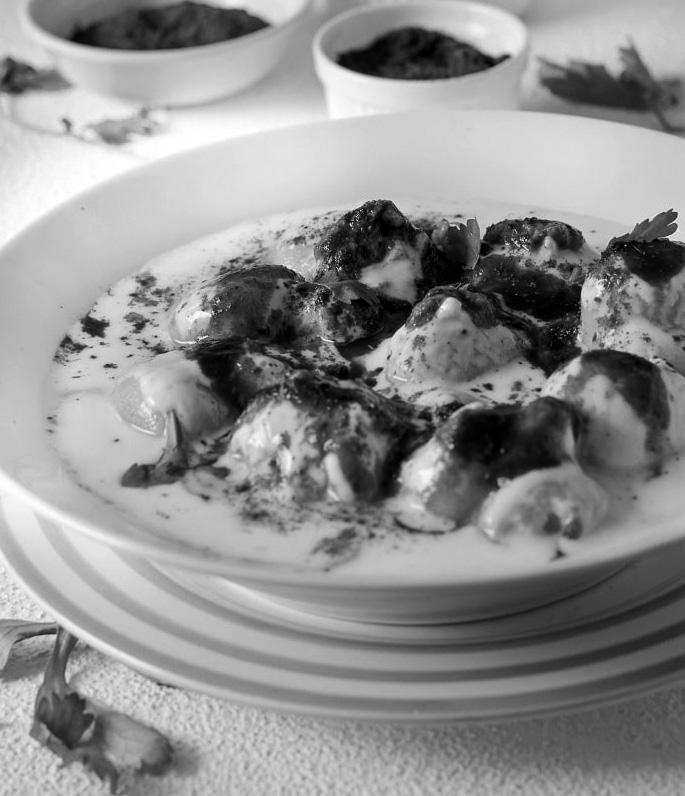
Hung curds (chakka dahi)
Grated paneer (cottage cheese)
Fried onions
Chopped cashewnuts (kaju)
Finely chopped coriander (dhania)
Bread crumbs
Chilli powder
Garam masala
Finely chopped green chillies
Sugar
cup
1¼ cups
cup
3 tbsp
tbsp
tbsp
1 tsp
tsp
tsp
pinch
taste
Bread crumbs for rolling
Green chutney
Method:
for deep-frying
for serving
1. Combine all the ingredients in a deep bowl and mix well.
Divide the mixture into 8 equal portions and shape each portion into a 50 mm. (2”) diameter round kebab.
3. Roll each kebab in bread crumbs so that the kebabs are evenly coated from both the sides.
4. Heat the oil in a deep non-stick kadhai and deep-fry 2 kebabs at a time till they turn golden brown in colour from both the sides.
Drain on an absorbent paper. Serve immediately with green chutney.
SIMPLE RULES OF HEALTH
CHIA SEEDS FOR HEALTHY BENEFITS
The popularity of chia seeds (Salvia hispanica) in Western diets has soared over the last several years.
The tiny, nutrition-packed “super seeds” are now a staple in many health-conscious households. Thanks to their small size, mild taste, and versatility, it’s easy to incorporate chia seeds into your diet.
Nutrition Benefits of Chia Seeds
According to the American Society for Nutrition, chia seeds provide insoluble fibre which helps keep you fuller longer and bulks up stool to prevent constipation. They also deliver healthy fats, protein, and cellprotecting antioxidants. Chia seeds are a good source of minerals, such as: calcium, iron, zinc, copper, manganese, niacin, magnesium.
Chia seeds may help control blood sugar. A randomized controlled trial published in Diabetes Care determined that adding chia seeds to normal type 2 diabetes treatments improves cardiovascular disease risk and
helps maintain good glucose and lipid control.
According to Dr. Andrew Weil on his web site, chia seeds have more omega-3 fatty acids than flaxseeds. Omega-3 fatty acids may reduce your risk of coronary artery disease and improve cholesterol levels. Unlike flaxseeds, chia seeds are rich in antioxidants and have a longer shelf life.
Ways to Eat Chia Seeds
Chia seeds have a mild taste and take on the flavour of whatever food or beverage they are added to. When added to liquid, they plump up several times their size and form a gelatinous coating which is easy to swallow and digest.
You may add chia seeds straight to products that have liquid, like juice or yogurt. Eating with purpose suggests making chia gel. You can make chia gel by stirring 1/3 cup of chia seeds into 2 cups warm water and letting the mixture thicken. The longer the gel sits, the thicker it gets. Chia seeds may also be ground.
1. Smoothies
A popular way to use chia seeds is in smoothies. A tablespoon or less of fresh seeds or chia gel is all you need to add texture and nutrients to your fruit and veggie smoothies.
2. Salad Dressings
Chia seeds blend well with salad dressing ingredients such as olive oil, vinegars, honey, lemon juice, Dijon mustard, and apple cider vinegar. The more seeds you add, the thicker the dressing.
3. Pudding
All you need to make vanilla bean chia pudding is almond milk, chia seeds, and vanilla beans.
4. Baked Goods
If you’re not a fan of chia seeds’ gelatine-like texture, try adding them to baked goods. Chia gel helps keep baked goods moist and may be used in place of eggs or as a thickener. Substitute 1 tablespoon of chia seeds mixed with 3 tablespoons of water for one whole egg in a cake recipe.
5. Granola, Protein Bars, or Energy Bars
Chia seeds give homemade granola, energy, or protein bars a fibre boost. Try making chia seed energy bars made from dates, coconut oil, chia seeds, vanilla, and any add-ins you
choose such as dark chocolate, coconut, and dried fruit.
6. Chia Drinks
Chia fresca, also known as “Mexican lemonade,” is a refreshing way to use chia seeds. This natural energy drink is made of water or coconut water, lemon or lime juice, chia seeds, and sweetener. For extra flavour, add a few sprigs of mint.
7. Popsicles
If you’re looking for a way to sneak nutrients to picky eaters, add chia seeds to homemade popsicles. Grab your ice pop moulds and make blueberry chia popsicles from almond milk, chia seeds, avocado, and frozen blueberries. Your kids will never guess they are eating healthy!
8. Breadcrumbs
Chia seeds make a great lowcarb substitute in recipes that use breadcrumbs as a binder. You will typically need to use less chia than breadcrumbs.
9. Jam
To make a simple chia seed jam, add 2 tablespoons chia seeds to about 2 cups of mashed fresh fruit. Add sweetener like honey or agave as desired, and let the mixture sit for at least 10 minutes. As the mixture sits, it will take on a jam-like consistency.
